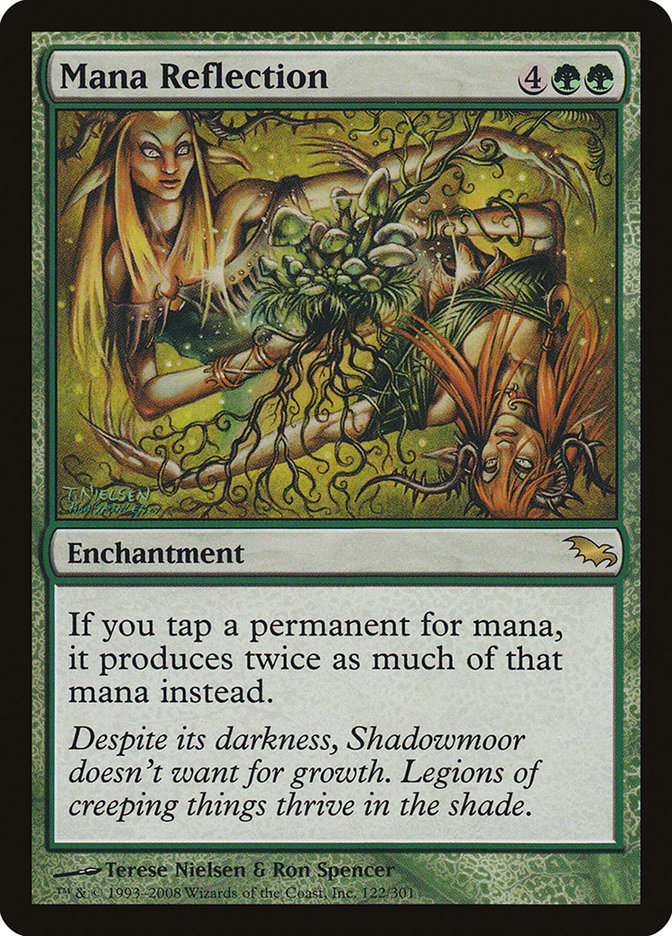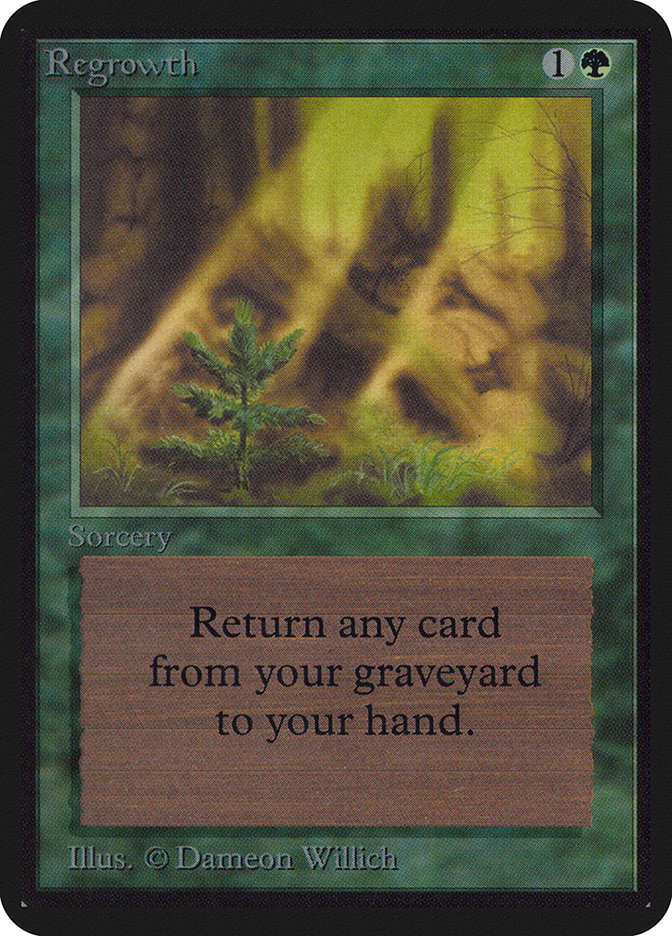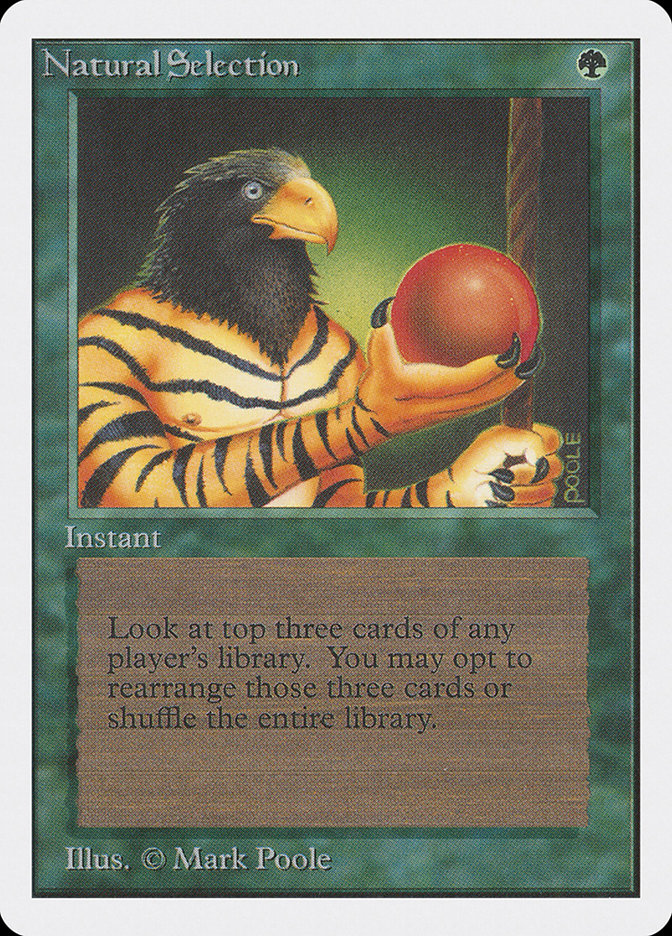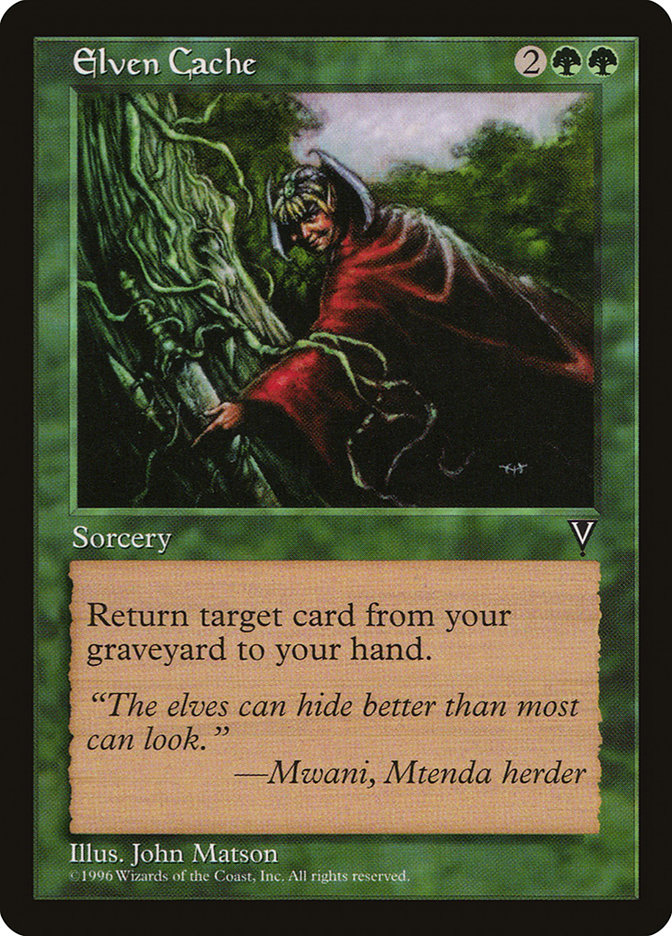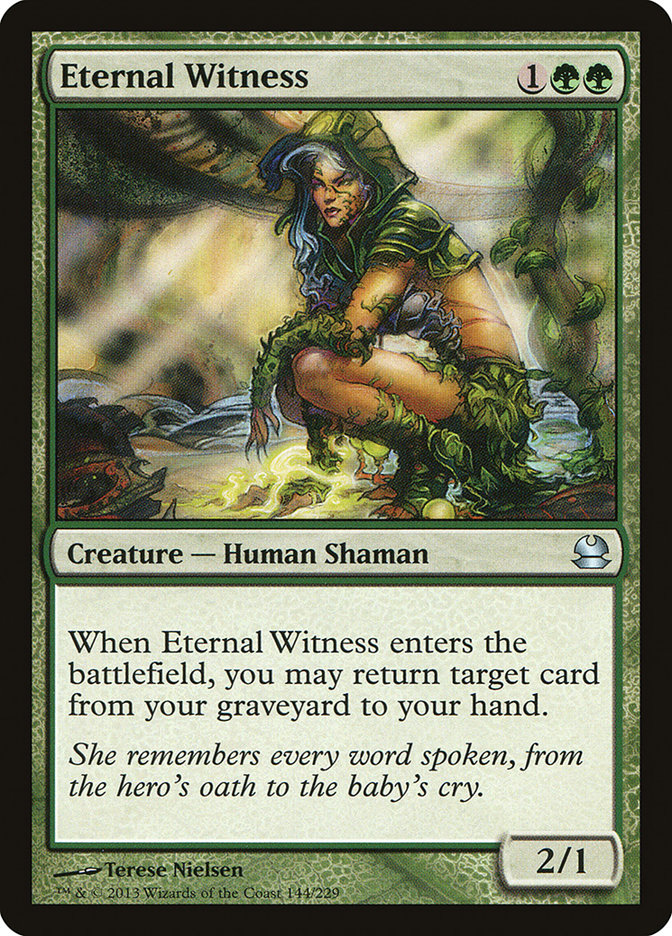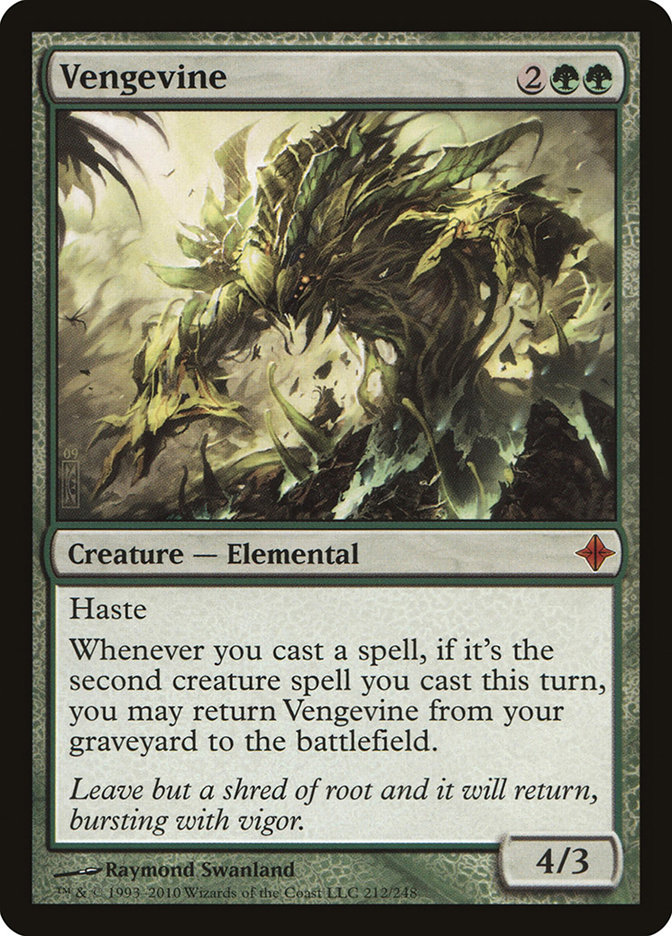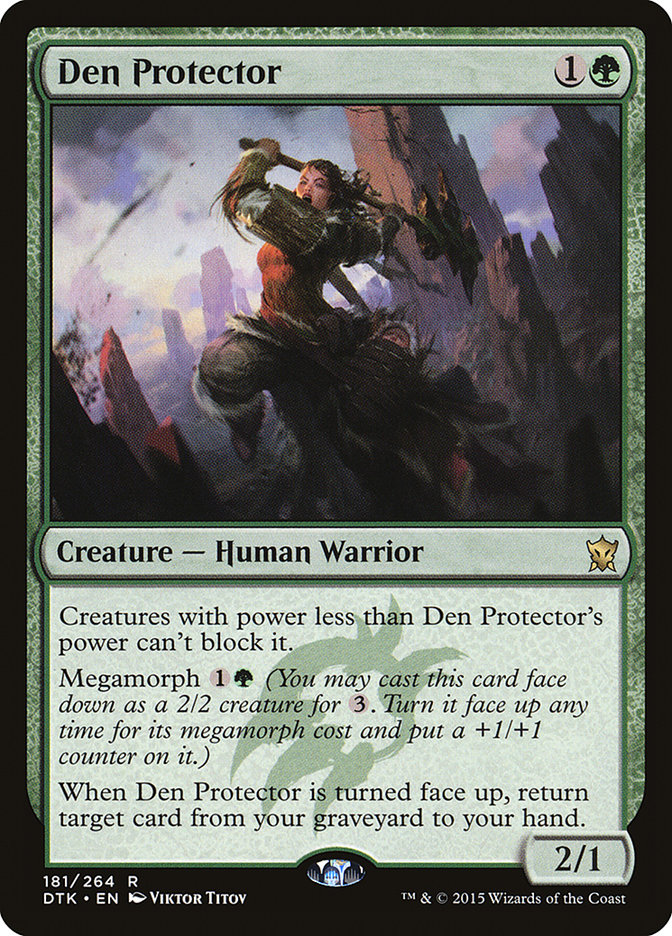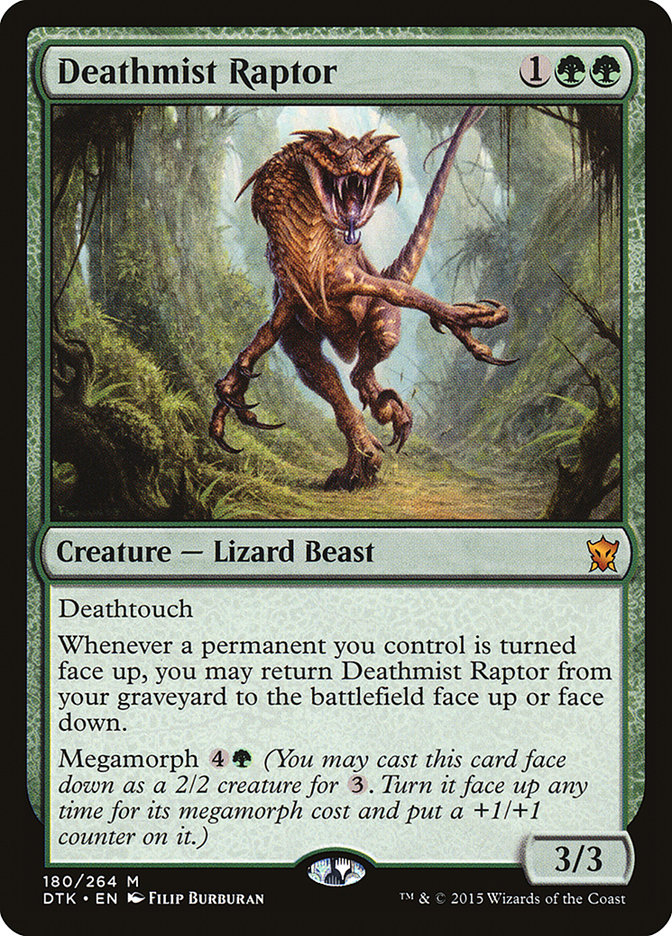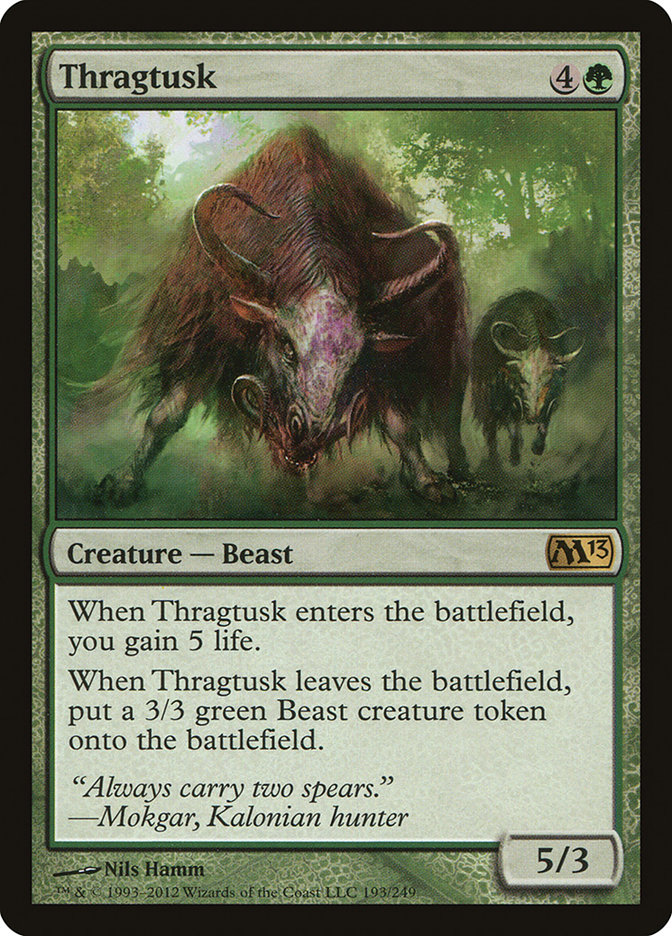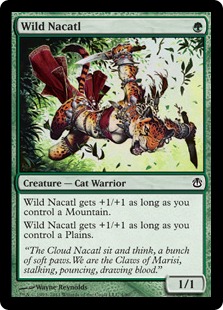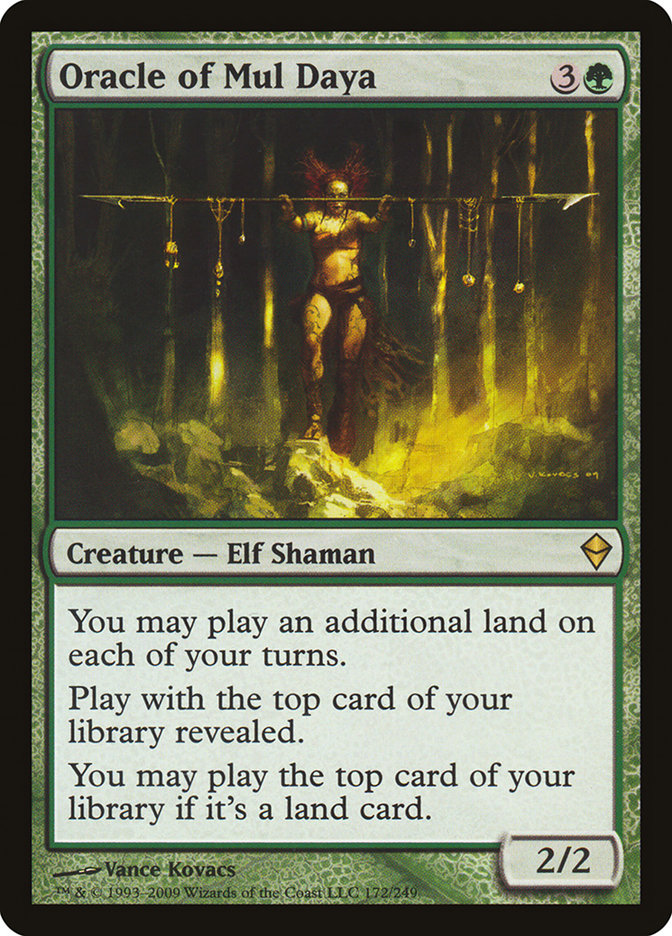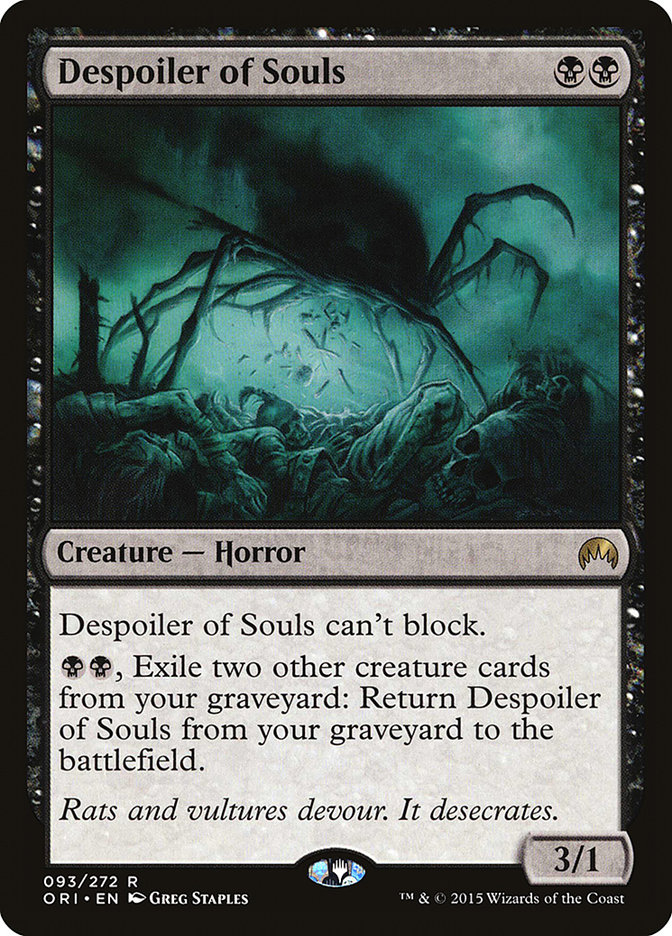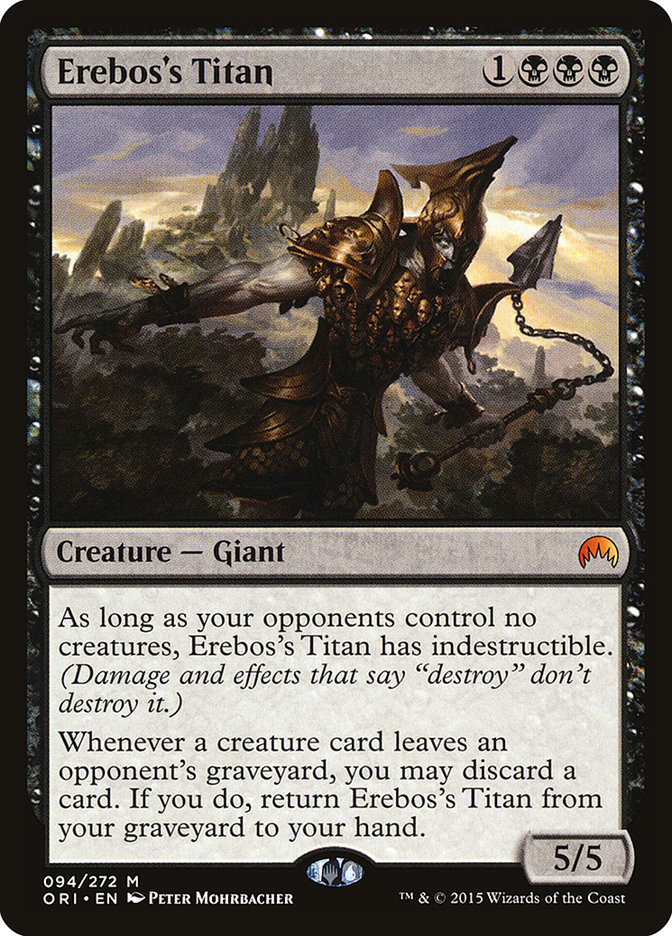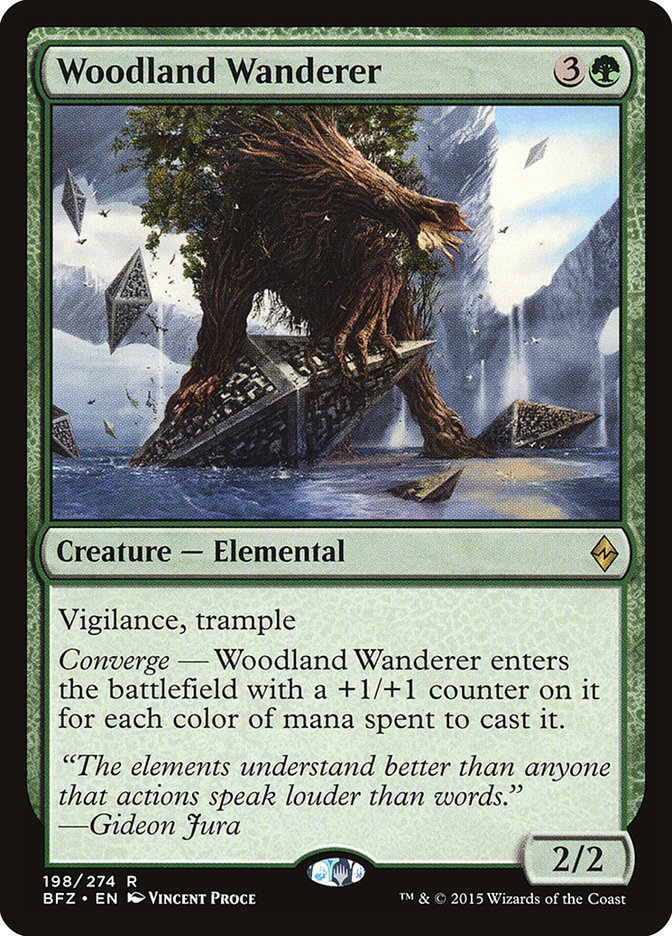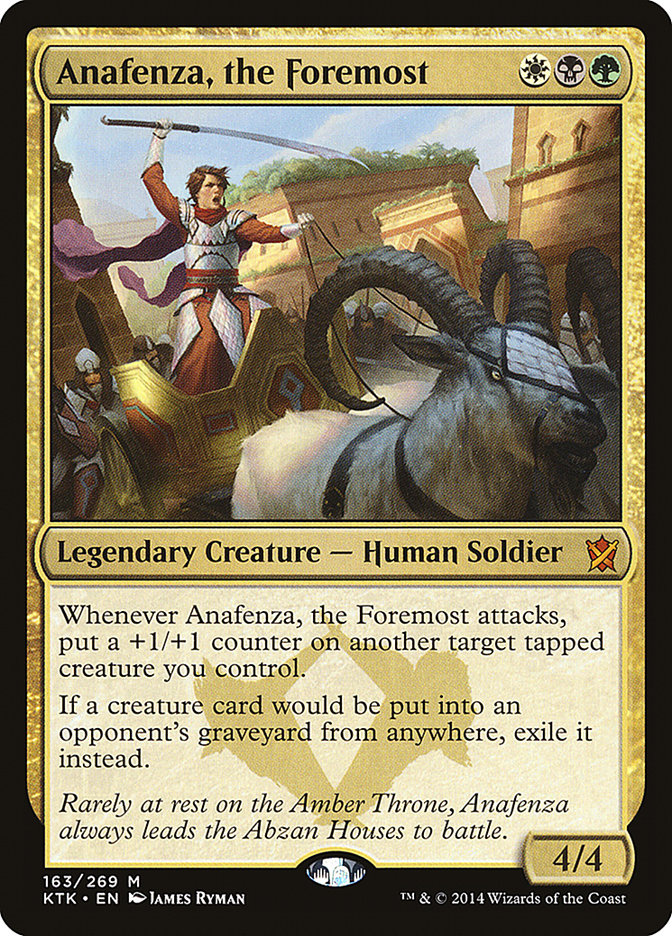Something very important has been going on, and even if people have noticed it and exploited it, not a lot of people are actually talking about it. It
involves the color green in Magic and the design space it occupies within the color pie.
Aggro, midrange, control, and combo have long been major labels we apply to define a deck’s general strategy. Magic’s design space is virtually infinite,
but the parameters of viable strategies aren’t. It’s rare that something besides aggro, midrange, etc. comes into existence (at this point, pretty much
never), but believe it or not, I think we’re starting to see just that within the color green.
If you’ve only been playing Magic a few years, you may not even understand the jokes about how much better blue is than green. Black, red, and white sort
of hang out in their own spaces, comfortable to keep their head down and support the blue cards while old pros laugh at green and cast Brainstorms.
Needless to say, that’s changed a lot over the last few years, and green is now a celebrated member of the color community. There are a few different
reasons for this, but the ones we’re most concerned with involve Standard-and probably eventually Modern, but we aren’t there yet.
Though it isn’t terribly important to the topic, for the sake of being thorough, I’ll mention Commander. You can’t deny the lucky break green caught with
Commander becoming a thing. Accelerating mana is the most enduring defining quality of green’s mojo, and it is one of the most, if not the most,
crucial element of Commander success. For years, cards like Mana Reflection were ignored altogether. How’s that working out?
But anyway, in competitive formats, traditionally, aggro went hard and lost if it didn’t make it in time, and control cast counterspells and draw spells
until a Wrath was found to seal the deal. Combo did its own thing and hoped to not be disrupted. This old paradigm no longer applies, at least not in its
entirety. For instance…
Creatures (24)
- 3 Wingmate Roc
- 4 Warden of the First Tree
- 2 Hidden Dragonslayer
- 4 Den Protector
- 4 Deathmist Raptor
- 3 Nissa, Vastwood Seer
- 4 Hangarback Walker
Planeswalkers (4)
Lands (25)
Spells (7)

Creatures (24)
- 3 Wingmate Roc
- 4 Warden of the First Tree
- 2 Hidden Dragonslayer
- 4 Den Protector
- 4 Deathmist Raptor
- 3 Nissa, Vastwood Seer
- 4 Hangarback Walker
Planeswalkers (4)
Lands (25)
Spells (7)

Creatures (24)
- 3 Wingmate Roc
- 4 Warden of the First Tree
- 2 Hidden Dragonslayer
- 4 Den Protector
- 4 Deathmist Raptor
- 3 Nissa, Vastwood Seer
- 4 Hangarback Walker
Planeswalkers (4)
Lands (24)
Spells (8)

For what it’s worth, I’m not one to shame a room of over 500 players, but it’s pretty hard to believe Michael Majors literally solved the format on the
first shot. Please. This is not a two- or three-deck format, but Jeskai Black and this deck accounted for an unreasonable amount of the field. Test
Hallowed Moonlight. Something. I realize there was only a week between the first two events, but come on. If the Pro Tour is 60% G/W Deathmist Raptor and
Den Protector decks, I’ll apologize to every last one of you, but until then, I’ll assume people are just being lazy. If you played Mardu Dragons this
weekend, I could kiss you on the mouth.
But anyway, since acting like G/W Megamorph is now the Caw-Blade of our time (like Atlanta did this past weekend) furthers my point, I’ll pretend like
that’s somewhat accurate (it isn’t).
Let’s travel back in time to Alpha. That is where it all started.
Although the color pie was pretty loosely defined back then…
What.
…coming back from the dead in some roundabout way was a very dulled part of green’s function. Reanimation was all about black, which is very intuitive
because black loves death and graveyards and all kinds of other scary unpleasant crap. As for green’s graveyard fun? It didn’t come up very often, and it
rarely did anything as important as Regrowth, a card that’s been restricted in Vintage for much of its existence.
Later on, it was hard to notice when this effect was really even around because it was so often rare (not in pack rarity but in playability). How many of
you ever sleeved this bad boy up?
Keep in mind, these cards existed at a time when spells were head and shoulders better than creatures. And yet, Elven Cache was about as good as this
effect got.
Then this little lady came along.
In case you didn’t know, she’s a good one.
Eternal Witness actually doesn’t see a ton of play compared to how popular she is, which is kind of weird. She’s extremely powerful, thought by many to be
one of the best green creatures of all time, but she really doesn’t appear in Constructed as often as that reputation would make you think. She sure as
hell doesn’t have the kind of absurdity or synergy to redefine Magic, or even one of its colors. She’s just that: very good.
Fast forward to Rise of the Eldrazi. This is where things get a little troubling.
Here, we come across Vengevine, a costly mythic that used to beat the hell out of people for the low low cost of “playing creatures.” It was relatively
difficult to find a permanent solution to Vengevine. Fauna Shaman and the bunch would ensure you always had plenty of juice to keep them recurring, like
some kind of messed up groundpounding Demigod of Revenge that refused to quit. In a lot of ways, Vengevine is the first major symbol of green permanently
taking control of graveyard recursion and not just screwing around with street debris like Nature’s Spiral and Reclaim. Black and white have always had
tricks in this vein, but the amount of umph green was doing within that field was getting pretty crazy when Vengevine was going nuts.
So, let’s start with how obviously dumb this is. I won a lot with Vengevine. In fact, I adored playing the green and white Quest for the Holy Relic deck of
the time due to its unforgiving nature. If you screwed up against a good deck, you lost. If you screwed up against a terrible deck, you lost. That deck
made a player or a loser out of you.
The important point to take away, however, is that Vengevine is stupid. It comes back from the graveyard and it isn’t black or white. It attacks with haste
because it’s angry, which is a red thing. Why not make it a playable Phoenix or something instead of a leaf monster? What is this garbage?
So why are we talking about Vengevine? Because the degeneracy of green’s refusal to stay within its own design boundaries has officially gotten out of
control.
Regrowth allowed Eternal Witness to exist. Eternal Witness allowed Vengevine to exist (for some reason). And now, here we are.
The first card I ever laid eyes on was a Birds of Paradise. That was 1996. I am a green mage in soul and spirit. My heart belongs to the color more than
any other in the game, so for me to say this should say something.
This s*** is so stupid.
For reference, aside from the “shaming the Atlanta crowd” paragraph from earlier and this one, this article was written entirely before the results of
Atlanta. My issues with these cards has nothing to do with their power level or their presence in Standard from a competitive standpoint. I could not care
less. Cards are good. Big deal. My problem is that green design has apparently reached a point where low-cost free value synergies-blatantly obvious
ones–create situations where green creatures can cast Regrowth, all the while bringing Vengevine-like entities out of the graveyard for absolutely no
extra cost. What the hell is this? When did Thragtusk and its brand of awesomely annoying kinds of cards stop being good enough to define green?
Blue gets counterspells, card draw, occasional artifact tricks, and giant idiot Sphinxes.
Black gets discard, disruption, removal, and reanimating.
Red gets burn, random card draw and discard, and haste creatures.
White gets mass removal, attack/block removal, lifegain, little creatures.
And in 2015…
Green gets mana creatures, ramp, flexible permanent removal, Regrowths with bodies attached, auto-reanimations, card draw, discard revenge (Obstinate
Baloth), hexproof stuff, lifegain, can’t be countered stuff…
You know, everything.
How much of the color pie does green need to establish its place as an equal among other colors and not this plethora of noise? Enough already!
In what universe is the color pie sacred when green gets this…
…and black gets this clown…
Or better yet, choke on this, metagame:
What is this?
What is this new category of deck that these new green nonsense cards have brought on? This game-violating mess where you can jam low-mana drop creatures
and still be better equipped to manage the lategame than the decks that have outdrawn you by five cards?
G/W Attrition? G/W Inevitability? G/W Annoying?
It doesn’t feel aggressive enough for aggro. It doesn’t feel card advantage-y enough to be control. It isn’t focused on one engine enough to be combo.
Most importantly, it doesn’t feel green.
We’re months past the release of Dragons of Tarkir; it isn’t significant that these cards are synergistic. Nobody is discovering the wheel here.
What we’re talking about is a new kind of strategy, whether intentional or not, where decks can be built as an impostor aggro green deck that keeps up with
the other fast strategies of the format, but in actuality, has a long and endless loop game that can keep itself around and competitive well into most
control decks’ lategames. This is vastly different than typical midrange decks that are just chunky “good stuff” decks that lie in between the two
extremes. These two cards in the same format (and again, set) aren’t horrifically bad for the format. They aren’t putting up scary percentages or
dropping attendance at tournaments.
But they are a fundamental issue with the way the game balances itself among its colors.
The first issue is that they blur the line that keeps things organized between Magic strategies. If I say aggro or control, you get a good idea of the
philosophy I’m referring to. Because these green loops have a foot in both camps, it breaks a lot of the rules that keep formats organized. Yeah, I think
this last weekend’s field lacked some creativity, but it wouldn’t surprise me if this deck did become a nuisance and I had to eat crow to the fine players
in Atlanta. (I lived in Atlanta for a time. I’m one of you and all that.)
The second reason I don’t approve of these sorts of loops is that it extends games too long. Control mirrors are historically the worst for going to time.
This new green dimension also stretches games out the same way control decks do. We don’t need more archetypes that make it hard to finish without
unintentional draws, and there are a ton of games that do just that because the control deck can’t maintain any permanent control over the megamorph loops.
Fetchlands further worsen this issue, and eventually, nobody wins.
Read that again.
Nobody wins.
Third, in this case anyway, the synergy that fuels this crap is so blatantly obvious that it isn’t even fun to discover it. Obviously it was a byproduct of
megamorph being in only one set, but both of these creatures may as well have come in packs together. It has no subtlety, no finesse; it’s just a
game-prolonger machine that anyone who has played Magic for more than a day could’ve put together. Imagine how much differently decks would have be to be
constructed if Deathmist Raptor were a black card.
The New Era
The “green sucks” chant has been outdated for years. I think we can finally slow down. Cards like Den Protector and Deathmist Raptor together in the same
format are a step in the wrong direction, but they have established that green’s insecurity with equality is long dead. Cards like…
…feel green.
Cards like this…
…feel mythic green.
Cards like this…
…do not.
Green deserves a good Regrowth effect in the format, but it doesn’t need to put two or three more creatures on the battlefield when it does it. It deserves
a hexproof threat with good stats, but it shouldn’t invalidate removal and interaction altogether. What happened to you, green? What is this infinite value
crap?! End the game already!
Commander
Since these stupid new green mechanics insist on unkillable degenerates running hog wild and sending rounds into turns every weekend, I may as well see how
annoying of a Commander deck I can make with them.
Creatures (21)
- 1 Solemn Simulacrum
- 1 Wood Elves
- 1 Genesis
- 1 Eternal Witness
- 1 Savra, Queen of the Golgari
- 1 Kor Skyfisher
- 1 Oracle of Mul Daya
- 1 Vengevine
- 1 Fauna Shaman
- 1 Sun Titan
- 1 Elesh Norn, Grand Cenobite
- 1 Karador, Ghost Chieftain
- 1 Craterhoof Behemoth
- 1 Blood Artist
- 1 Thragtusk
- 1 Ghoulcaller Gisa
- 1 Den Protector
- 1 Deathmist Raptor
- 1 Liliana, Heretical Healer
- 1 Hangarback Walker
- 1 Greenwarden of Murasa
Planeswalkers (3)
Lands (34)
- 1 Brushland
- 7 Forest
- 1 Llanowar Wastes
- 3 Plains
- 1 City of Brass
- 5 Swamp
- 1 Scrubland
- 1 Savannah
- 1 Bayou
- 1 Karakas
- 1 Windswept Heath
- 1 Dryad Arbor
- 1 Verdant Catacombs
- 1 Bojuka Bog
- 1 Evolving Wilds
- 1 Razorverge Thicket
- 1 Command Tower
- 1 Homeward Path
- 1 Isolated Chapel
- 1 Woodland Cemetery
- 1 Sandsteppe Citadel
- 1 Canopy Vista
Spells (42)
- 1 Wrath of God
- 1 Reanimate
- 1 Swords to Plowshares
- 1 Sol Ring
- 1 Regrowth
- 1 Demonic Tutor
- 1 Ancient Craving
- 1 Natural Order
- 1 Grave Pact
- 1 Darksteel Ingot
- 1 Plague Wind
- 1 Mirari's Wake
- 1 Decree of Pain
- 1 Worldly Tutor
- 1 Skullclamp
- 1 Victimize
- 1 Natural Affinity
- 1 Syphon Mind
- 1 Explosive Vegetation
- 1 Hymn of Rebirth
- 1 Infernal Tribute
- 1 Mulch
- 1 Survival of the Fittest
- 1 Reprocess
- 1 Greater Good
- 1 Golgari Signet
- 1 Selesnya Signet
- 1 Coldsteel Heart
- 1 Damnation
- 1 Harmonize
- 1 Austere Command
- 1 Primal Command
- 1 Profane Command
- 1 Mana Reflection
- 1 Nature's Spiral
- 1 Dreamstone Hedron
- 1 Green Sun's Zenith
- 1 Beast Within
- 1 Jarad's Orders
- 1 Read the Bones
- 1 Hedron Archive
- 1 Painful Truths

There we have it. A first pass gives the deck traditional reanimation, auto-reanimation, plenty of creature tutoring, and of course because this is
Commander and not Standard, a complete ability to get hosed by opposing players who could not care less about my stupid graveyard because healthily hating
on this stuff is easy. If only it was this easy to hate on graveyards in Standard…
Try harder!


